FY 2003 Performance Report
 WELCOME WELCOME
SECTION I: Who We Are and What We Do
RD&T Organization
RD&T Leadership Council
Giving Back to the Community
SECTION II: The Strategic Framework
The FHWA R&T Program
Vision and Mission
FHWA Goals and Objectives for FY 2003
FHWA “ Vital Few ”
FHWA Roles
RD&T Corporate Missions and Functions
The Corporate Master Plan for Research and Deployment of Technology & Innovation
Corporate R&T Focus
Guiding Principles for FHWA’ s Corporate Role in R&T
R&T Leadership Team
SECTION III: Our Business Results
RD&T Challenges, Commitments, and Achievements
Research Project Status Summary
RD&T Success Stories
SECTION IV: RD&T Performance Management
Relevance, Quality, and Performance
Planning and Priority Setting
Performance Management Framework
Performance Management Workgroup
RD&T Research Benefits Case Studies
Case Study Highlights
Customer Feedback
RD&T Lab Assessment Process
Stakeholder Advisory Activities
and Feedback
APPENDICES
- RD&T Research Project Status
-
RD&T Services
-
Market - Ready Technologies
-
FHWA Research and Technology Partnerships
-
FHWA Educational Outreach Partnerships
-
Abbreviations
W E L C O M E
The Office of Research, Development, and Technology
(RD&T) provides leadership to the Federal Highway Administration (FHWA) Research and
Technology (R&T) Program and plays a key role in guiding the Agency’s
R&T Leadership Team as it implements the Corporate Master Plan for Research and Deployment of Technology & Innovation. The FHWA R&T program directly supports the goals of the U.S. Department of Transportation (USDOT) and focuses on addressing significant transportation challenges that our Nation faces today. At FHWA, our mission of “Enhancing Mobility through Innovation, Leadership, and Public Service” and our role as “Innovators for a Better Future” reinforces
the importance of technology and innovation (T&I) to the Nation’s transportation system and our customers. FHWA’s research leadership emphasizes information-sharing and partnerships with State and local governments, academia, and the private sector to quickly and cost-effectively
transform new technologies and concepts into better transportation systems, processes, and services.
The Turner-Fairbank Highway Research Center (TFHRC) facility is a federally owned and operated research
facility in McLean, VA, that contains more than 24 indoor and outdoor laboratories (labs) and support facilities, providing advanced research and development (R&D) innovations
for U.S. and international highways. TFHRC houses more than 300 Federal and contract transportation researchers,
students, and support personnel. This, our second annual performance report, represents our office’s commitment to accountability in the programs and initiatives managed at TFHRC. The first part of the report provides additional insight into our research facility, personnel skill levels,
programs, and initiatives. Not only does the report highlight our accomplishments and success stories of the past year, but it also conveys our management philosophy and the strategies we employ to achieve our goals and address new challenges. Additionally, it includes examples of how our organization strives to “give back” and enhance the
quality of life for our local community. This is a companion
document to the Fiscal Year (FY) 2002/2003 Performance Plan and 2002/2003 Catalog of Products and Services.
We hope that this report encourages you to learn more
about RD&T’s people, labs, services, and research. Our
office undertakes and completes research that is essential, indispensable, and connected to our stakeholders. I sincerely welcome
your feedback on this performance report and encourage you to provide comments and improvement suggestions through the TFHRC Web site at https://www.fhwa.dot.gov/research/tfhrc/. A “Performance Report Feedback” link was added to our home page to encourage and facilitate your input. Thank you for letting us know how we may better serve you.
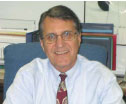
Dennis C. Judycki
Associate Administrator for Research, Development,
and Technology
I . WHO WE ARE AND WHAT WE DO
We continually seek to promote partnerships with State and
local governments, academia, and the
private sector to quickly and cost-effectively transform new technologies, concepts, and ideas into better transportation systems, processes, and services.
The R&T process is a continuous one that involves
regular feedback throughout the various phases to drive strategic decisionmaking. To carry out the program effectively and efficiently, the Office of RD&T develops and executes
policy, budget, program management, and evaluations that support the overall R&T program. RD&T projects span many disciplines and transportation topics, from highway
design, engineering, and maintenance to economic analysis, human factors, travel surveys, outreach, and marketing.
RD&T has six offices involved in research and program
support activities at TFHRC. The Office of Safety R&D, Office of Operations R&D, and Office of Infrastructure
R&D conduct research that continually improves highway safety, operations, and infrastructure, respectively. More than
300 employees and contractors at TFHRC work in a variety of occupations and specialties; job positions include
engineers, scientists, psychologists, and program support specialistsfrom a variety of disciplines. Our activities cover major
subject-matter areas such as human-centered systems, materialstechnology, operations and intelligent transportation
systems (ITS), pavements, safety, and structures. More than 50 percent of RD&T staff have advanced degrees; 20
percent hold one or more doctoral degrees.
In addition, our organization serves as the focal point
for FHWA participation in cooperative research activities,
such as the National Cooperative Highway Research Program (NCHRP) and the Transportation Pooled Fund (TPF) program. In FY 2003, the TPF program included 139 FHWA-led projects and 151 State-led projects valued at
approximately $130 million—with the average study valued around $467,000. Each project averaged 7 partners for State-led
projects and 9.8 for those led by FHWA. RD&T also conducts outreach to universities and the small-business community.
Our approach to research supports FHWA’s emphasis on cooperation, information sharing, and formal research agenda development within USDOT and across the entire government. We continually seek to promote partnerships with State and local governments, academia, and the
private sector to quickly and cost-effectively transform new
technologies and concepts into better transportation systems, processes, and services. Appendices D and E of this report provide an overview of the extensive partnership
activities that involve FHWA. Our emphasis on conducting world-class research includes a commitment to improve our business processes and efficiently operate the RD&T facilities,
organization, and programs. Our business process improvements are highlighted in the “Challenges and Commitments”
section of this report and the “Services” tables in appendix B.
Career development and enrichment are key focus areas for our organization. FHWA offers a variety of educational
outreach and career development programs, including FHWA’s Professional Development Program (PDP), the USDOT-wide Summer Transportation Internship Program for Diverse Groups (STIPDG), and Federal Government-wide programs such as the Executive Leadership Program and the Executive Potential Program. RD&T is committed to reaping the
benefits of the diverse new perspectives and fresh ideas that these
program participants offer. We aggressively seek and provide new learning opportunities for program participants whenever
possible. For more information on this, see appendix E.
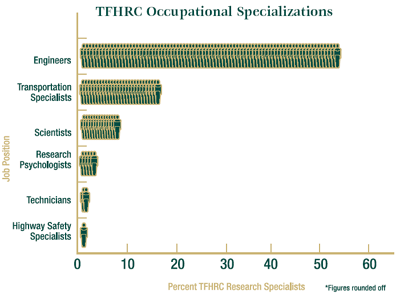
In addition to educational outreach, RD&T provides a
variety of marketing and communications services that support FHWA T&I deployment initiatives. These services include
marketing and communications strategic planning, exhibits, special events planning, and report and periodical publishing,
including Public Roads, R&T Transporter, and Focus.
RD&T Organization
Infrastructure R&D (HRDI)
The Office of Infrastructure R&D focuses on improving
the performance of highway infrastructure and significantly
reducing associated long-term costs. The comprehensive and
coordinated Infrastructure research program utilizes R&T that cuts across the boundaries of Asset Management, Pavements, and Structures. It focuses on the four critical elements
needed for success: information, people, technology, and deployment
of that technology.
Operations R&D (HRDO)
The Office of Operations R&D conducts research to
mitigate congestion and improve safety through better management
and operation of the surface transportation system. The Travel Management Team produces various hardware and software tools to analyze operational improvements, reduce
congestion on surface streets and freeways, and mitigate delays in
work zones. The Enabling Technologies Team is developing
infrastructure-based systems that will warn motorists of potential intersection collisions; promoting safety by developing
decision support tools for winter weather maintenance; and
supporting the development and use of safety-enabling technologies
such as Dedicated Short-Range Communications and Nationwide Differential Global Positioning Systems (NDGPS).
Safety R&D (HRDS)
The Office of Safety R&D aims to reduce highway
crashes and related fatalities and injuries by developing and
implementing a program of safety innovations through nationally
coordinated R&T. The focus is on FHWA’s priority highway safety
improvement objectives related to preventing and mitigating roadway departures, managing safety, improving intersections, and
protecting pedestrians. This office provides transportation officials and practitioners with improved understanding, information, and state-of-the-art tools to aid informed decisions on
highway safety improvements. The office also conducts advanced research to determine new ways to solve highway safety
problems and challenges.
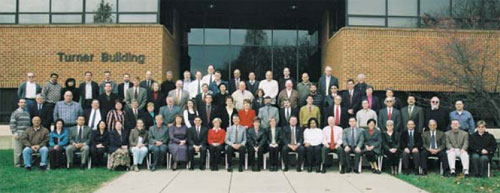 |
| The Federal researchers and staff at TFHRC. |
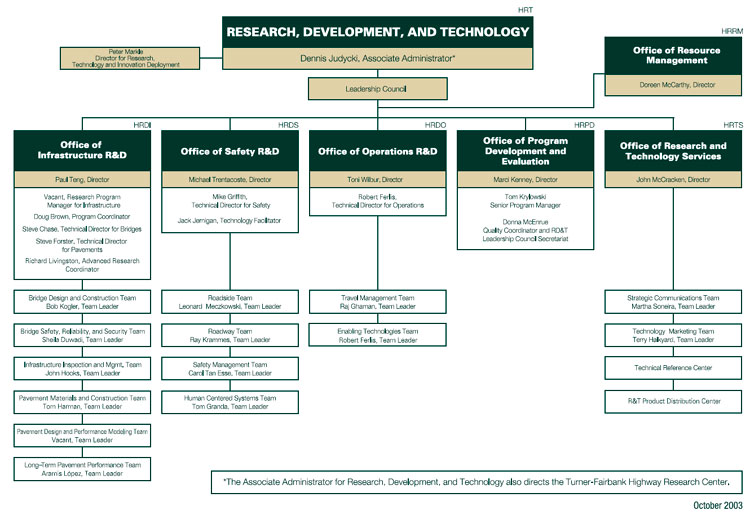
Program Development and Evaluation (HRPD)
The Office of Program Development and Evaluation (HRPD)
champions the research, development, and technology program and those it serves by developing and executing policy,
budget, program management, and evaluation tools to further FHWA’s R&T program. HRPD also is the focal point for FHWA’s
participation in cooperative research activities such as the NCHRP and TPF studies, and active outreach to University
Transportation Centers (UTC) and the small-business community.
Resource Management (HRRM)
The Office of Resource Management (HRRM) provides critical management support services that contribute to RD&T’s research and deployment of T&I activities. HRRM staff
provides advice, assistance, and support for financial management
of R&T and General Operating Expenses funding,
acquisition planning, and contract administration for research programs and research support activities, human resource management and employee development, information technology support for research and business applications, accountable property
management, TFHRC facilities management, emergency planning, FHWA continuity of operations support, and physical
security.
Research and Technology Services (HRTS)
The Office of Research and Technology Services leads in
leveraging T&I deployment, one of the Agency’s key business processes. HRTS also provides various marketing and communication services Agency-wide, as well as within RD&T. These include planning and executing the FHWA-wide exhibit
program; administering the R&T Products Distribution Center; editing, publishing, and distributing RD&T research
reports; overseeing TFHRC Web pages; and publishing periodicals,
like Public Roads, that reach customers worldwide. HRTS also
supports the implementation of the Corporate Master Plan for Research and Deployment of Technology & Innovation.
Director for Research, Technology, and Innovation Deployment
The Director for Research, Technology, and Innovation Deployment provides key support to the Associate Administrator for RD&T in the role of FHWA's champion
for R&T. The Director works with FHWA leadership to
"e-bar" for research and deployment of T&I and facilitates the development and ongoing implementation of the FHWA Corporate Master Plan for Research and Deployment of Technology & Innovation.
RD&T Quality Coordinator/Leadership Council Secretariat
Provides leadership for the quality program within
RD&T, which includes coordinating annual Quality Self-Assessment activities. It actively utilizes the RD&T Leadership
Council to address quality management initiatives, such as developing and implementing the lab assessment program, and developing and tracking Leadership Council Action Agenda initiatives.
RD&T Leadership Council
The mission of the RD&T Leadership Council is to
continuously improve the RD&T organization and its achievement of the FHWA strategic goals. The Council works on a wide
range of issues related to the effective management of TFHRC and serves in an advisory capacity to the RD&T Executive Committee (which consists of the Associate Administrator
for RD&T, the Director for Research, Technology, and
Innovation Deployment, and the RD&T office directors).
Council Goals and Objectives
- Develop priorities for innovative technologies and approaches to R&T.
- Set a research agenda that meets customer requirements.
- Conduct quality research that efficiently and
effectively delivers products.
- Deliver high-value work that is relevant to FHWA and USDOT missions.
- Balance effectively the cost, time, and risk of R&T
projects managed by RD&T.
- Support dissemination of best practices, solutions, and success stories.
Workgroups Reporting to the Leadership Council:
- Performance Management.
- Customer Survey.
- Information Technology.
- Communications.
- Corporate Focus.
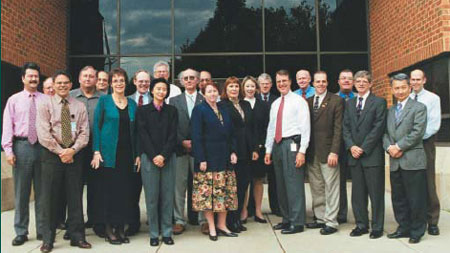 |
| RD&T Leadership Council. |
Giving Back to the Community
Fairfax County Fire and Rescue Training
For the past 6 years, firefighters from 2 Fairfax County,
VA fire and rescue departments practiced removing pinned and trapped motorists (using crash dummies) from automobile crash tests at the TFHRC Federal Outdoor Impact Lab
(FOIL). Normally, these firefighters and rescue workers practice
their rescue techniques on junked cars at the Fairfax County
Fire and Rescue Academy. However, using crash-test vehicles
from the FOIL provides them with a more challenging training
exercise, because the FOIL better simulates actual crash conditions. As a result, firefighters who train at the FOIL improve
their equipment skills and their rescue techniques in
preparation for real-life emergencies.
Preserving the Past
When FHWA’s predecessor organization, the Bureau of Public Roads, acquired land in 1940 for a dedicated roadway
research facility, it also acquired some local history. The Langley Research Station facility site, which is now TFHRC, wrapped around a private family burial ground, about 0.1 hectare (.25 acre) in size. Lawrence M. Reid, who sold the U.S. Government property rights to the full 235.3 hectares (581 acres), retained property and access rights to the burial site,
which dates back to 1855. TFHRC has cared for the site over the years, gathering burial information and developing a plan
view of the cemetery and its landscaping. Current restoration
efforts used the survey information to build an enclosure fence
for the cemetery. Plans include placing a historic marker to
describe the significance of the site, and new landscaping will
augment the cemetery's historic plantings.
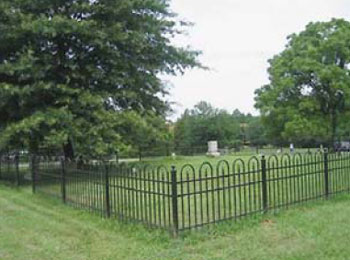
Youth Educational Outreach
Part of the organizational culture at RD&T is an
emphasis on societal responsibility, community involvement, and
mentorship. RD&T enthusiastically encourages future transportation professionals, and we offer hundreds of students the
opportunity to learn firsthand about the role of R&T in the
Nation’s transportation system, and the wealth of transportation
career options. These activities support the educational
community at all levels, from research fellow grants to kindergarten
through senior high school (K-12) age-appropriate outreach
activities. For several years, our research engineers have spoken to
and made presentations to local elementary schools to interest
students in the engineering profession. RD&T supports other
K-12 educational outreach activities include hosting job
shadowing on Groundhog Day, Take Your Son/Daughter to Work Day, and the National Engineer Week’s Future City Competition, which brings together seventh- and eighth-grade students
and engineers to develop models of future cities. FHWA
sponsors an award to the Future City team that best incorporates
transportation elements in its prototypical design.
Student Volunteer Program
Our efforts to expand the Student Volunteer program at
TFHRC focus on establishing partnerships with local
universities. The program serves as the basis for encouraging students to
obtain practical experience, conduct meaningful research, and
provide a fresh perspective to our highway research program.
Volunteerism
At TFHRC, we give back to the community through a number
of other activities. RD&T supports the annual Combined
Federal Campaign with a number of creative fundraising and social events, such as the Chili Cook-Off, bake sales, and
auctions. Proceeds go to many worthy causes and a special donation
is made to the Oklahoma City Scholarship Fund, which benefits the family members of FHWA employees who lost their lives
in the Murrah Building tragedy. Throughout the year,
employees also collect donations for a Washington, DC, area senior
center and sponsor semiannual blood drives to support the
American Red Cross of the National Capital Area. Other RD&T
public outreach activities include exhibits on the National Mall
in Washington, DC, for Public Service Appreciation Week and National Transportation Week.
Facility Tours
TFHRC conducts facility tours, which create awareness
among critical audiences and deliver the message that RD&T
research provides innovative, real-world solutions to a number of
highwayrelated problems. Each year, TFHRC offers tours to hundreds of guests, such as senior legislative and USDOT
decisionmakers, congressional staffers, international research colleagues,
FHWA State and local partners, and members of professional
organizations and associations. Guests visit the labs and learn about research projects that benefit our Nation’s transportation
system.
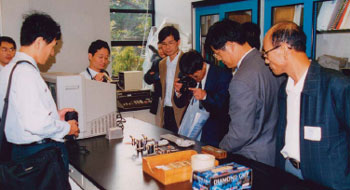
Back to Top
II. The Strategic Framework
FHWA’s research approach emphasizes cooperation, information sharing, and formal research agenda development.
The FHWA R&T Program Managing
FHWA’s R&T program and communicating with our partners are important components of the RD&T
mission. FHWA’s research approach emphasizes cooperation, information sharing, and formal research agenda
development with State and local governments, academia, and the private sector. The RD&T performance plan illustrates RD&T’s alignment with the USDOT and FHWA vision,
mission, and goals; documents activities that will produce results; and lists the RD&T products and services.
Vision and Mission
FHWA’s new vision statement reflects a systemwide approach to improving transportation. Furthermore, the Agency’s revised mission statement, “Enhancing Mobility through Innovation, Leadership, and Public Service,”
affirms that research and innovation are integral to its mission.
In fact, one of FHWA’s three primary roles is to be
“innovators for a better future.” This key rewording of the mission reflects R&T’s important contribution to enhancing
mobility, and it underscores FHWA’s commitment to organizationally “raise-the-bar” on research and deployment of T&I.
DOT Vision (FY 2003)
Safer, simpler, smarter transportation solutions.
|
FHWA Vision
Improving transportation for a
strong America. |
RD&T Vision
An RD&T organization that is essential, indispensable, and connected
to our partners in advancing R&T. |
DOT Mission (FY 2003)
Develop and administer policies and programs that contribute to providing fast, safe, efficient, and convenient transportation at the lowest cost consistent with the national objectives of general welfare, economic growth and stability, the security of the United States, and the efficient use and conservation of the resources of the United States.
|
FHWA Mission
Enhancing mobility through innovation, leadership, and public service. |
RD&T Mission
Leads in developing a nationally coordinated research and technology
program; champions the advancement of highway technological innovation
in support of FHWA strategic goals and performance objectives; advances
knowledge through research, development, testing, and evaluation services;
and provides support and assistance throughout FHWA in matters relating
to RD&T. |
FHWA Goals and Objectives for FY 2003
Safety
- Reduce fatalities involving roadway departure (run-off-theroad and head-on) crashes.
- Reduce intersection-related fatalities.
- Reduce pedestrian-related fatalities.
- Support national safety strategies, including an
increase in use of seat belts.
Mobility and Productivity
- Further deploy ITS infrastructure and sustain
improvements to system operating practices.
- Mitigate overall impacts of congestion through effective local partnerships.
- Reduce work zone delay by ensuring that all States, the District of Columbia, Puerto Rico, and Federal Lands offices are engaged in aggressively anticipating and mitigating
congestion caused by highway work zones.
- Reduce traffic incident delay by ensuring that all
States, the District of Columbia, Puerto Rico, and Federal Lands
offices are engaged in aggressively anticipating and mitigating
congestion caused by traffic incidents.
- Improve and expand the National Highway System to increase system efficiency and return on investment.
Environment
- Provide training and technical assistance to our
partners to minimize the potential adverse environmental impacts of Federal-aid and Federal Lands projects.
- Enhance knowledge of FHWA staff in ecosystem and habitat conservation, and showcase existing exemplary initiatives.
- Reduce on-road mobile source emissions.
National Security
- Identify critical highway infrastructure, evaluate its
risk and vulnerability, and develop measures to reduce
vulnerability.
- Ensure preparedness for response to, and recovery from, malevolent attacks on highway infrastructure.
- Facilitate military deployment from forts to ports.
- Initiate research, technology development, and
deployment activities in support of a more secure highway system.
Organizational Excellence
- Provide stewardship of funds and coordinate efforts to ensure that our partners maintain good accountability for expenditures.
- Establish timeframes for all current projects requiring Environmental Impact Statements (EIS) or Environmental Assessments (EA); continue to reduce the environmental processing time for all EIS and EA projects.
- Develop and implement the FHWA Human Capital Plan and the Restructuring Assessment Task Force recommendations for Professional Development and Training.
- Establish, implement, and monitor a system of customer surveys and Agency response to the feedback to improve customer service and satisfaction.
- Lead and coordinate efforts to effectively perform the
role of Innovators for a Better Future, and increase the
effectiveness of all FHWA units, as well as of our partners and
stakeholders, in determining priorities and deploying T&Is.
FHWA “Vital Few”
The Agency’s focus on Safety, Congestion Mitigation, and Environmental Stewardship and Streamlining reflect FHWA’s desire to commit resources in areas where critical
performance gaps exist and where the greatest impact can be made.
Performance in these areas will define success for our
Agency and affirm the need for a Federal role in highway
transportation.
FHWA Roles
Based on extensive discussions, in 2001 the FHWA
Leadership Team developed three role statements that affirm FHWA’s
new mission and declare our identity. In support of the Agency roles, TFHRC commits to:
- Coordinating R&D with and for our stakeholders and
partners.
- Supporting an environment that encourages innovation deployment.
- Creating improved technology and innovation deployment processes.
As innovators for a better future, TFHRC provides FHWA,
its stakeholders, and customers—the world highway community—with the most advanced R&D related to new highway
technologies —focusing on solutions to complex technical problems by developing economical, environmentally sensitive designs;
efficient, quality-controlled construction practices; and durable materials, all of which will create a safer, more reliable
highway transportation system.
RD&T Corporate Missions and Functions
RD&T performs several key functions to champion the advancement of highway technological innovation throughout FHWA. The following examples illustrate some of RD&T’s unique functions in support of the Agency’s role as “innovators for a better future.”
Highway Research and Development
- Research and innovation.
- Technical assistance.
- Forensic evaluation.
- Management of FHWA Highway Research Center.
Implementation of the Corporate Master Plan
- Support of FHWA R&T Leadership Team in the
implementation of the Corporate Master Plan for Research and Deployment of Technology & Innovation.
- Champion for Corporate R&T.
Strategic Planning and Budget
- R&T budget formulation and execution.
- Legislative monitoring and analysis of R&T issues.
- R&T performance measurement framework development.
- Agency input into USDOT RD&T Plan.
Outreach, Communication, and Consultation
- Research liaison and partnership activities.
- R&T marketing.
- Publishing and promoting FHWA R&T information.
- TFHRC visits/tours.
The Corporate Master Plan for Research and Deployment of Technology & Innovation
FHWA developed an Agency-wide plan for R&T, the Corporate Master Plan (CMP) for Research and Deployment of
Technology & Innovation. The CMP recognizes that R&T is an
Agency-wide program, involving headquarters program offices, RD&T,
and FHWA field offices. The CMP continues to expand the
effectiveness and efficiency of R&T, with special emphasis on deploying and implementing technologies and innovations to improve the quality, cost-effectiveness, and timeliness of
products, procedures, processes, practices, and/or techniques. It sets out a role, new focus, and guiding principles for the
FHWA R&T program to improve highway transportation, and
outlines FHWA’s corporate strategy for investing in and conducting cooperative research with partners and stakeholders. In
implementing this plan, the Agency is committed to engaging
stakeholders throughout the R&T process and effectively communicating the R&T program, which includes
publishing an Agency-wide R&T performance report. The CMP
elaborates 26 agency commitments to address the 7 guiding principles.
It is available on the FHWA Web site at:
https://www.fhwa.dot.gov/legsregs/directives/policy/cmp/03077.htm.
Corporate R&T Focus
In the FHWA FY 2004 Performance Plan, the Agency is
committed to evaluating the effectiveness of R&T. Under the CMP,
the Agency has committed to developing, defining, and adopting
a framework for measuring performance. The framework will align with strategic and performance plans, and allow FHWA
to evaluate R&T at the Agency, program, and project
levels.
Guiding Principles for FHWA’s Corporate Role in R&T
- The FHWA R&T process, from research through
implementation, is systematic and begins with the end in mind.
- FHWA engages in advanced and applied research and
innovation deployment activities where there is an appropriate Federal role.
- Stakeholders are engaged throughout the R&T
process.
- The R&T process is grounded in the FHWA mission and goals and guided by multiyear plans.
- The R&T budget allocation is based on and driven by multiyear plans and priorities.
- FHWA measures the performance of R&T on the Agency, program, and project levels.
- FHWA effectively communicates its R&T program and
projects.
R&T Leadership Team
To ensure a corporate approach to R&T and to implement
the CMP, the FHWA has formed an R&T Leadership Team consisting of Associate Administrators for Environment and Planning, Federal Lands, Infrastructure, Operations, Policy,
Professional Development, Safety, and RD&T; the Directors of Field Services; and a Division Administrator’s Council member.
The Associate Administrator for RD&T has a key role on the
R&T Leadership Team as champion for the FHWA R&T program and for facilitating and supporting the Leadership Team in implementing the CMP.
Back to Top
III. Our Business Results
RD&T Challenges, Commitments, and Achievements
To guide our business and performance plan, the RD&T Leadership Council’s vision is to conduct research and
provide products and services that are essential, indispensable,
and connected to our customers and partners. We are committed to continuing our quality journey (the process that FHWA
uses to regularly assess its management practices); initiating
program, process, and quality-of-work-life improvements; conducting outstanding research; and providing services that exceed performance indicators, strategic goals, and
customer and partner expectations. The following are our top
challenges and some key achievements related to fulfilling them:
-
Effectively Deliver Needed Products and Services
- Develop quality research products and services that address the needs of our internal customers and external partners in a timely manner.
- RD&T customer surveys provide our staff with
valuable feedback on our research, which spans many disciplines and transportation topics, from highway design,
engineering, and maintenance to economic analysis, human factors, travel surveys, outreach, and marketing. The project and services tables in appendices A and B provide status reports on RD&T research projects, and list the
various services provided over the past year to our customers and partners. RD&T also makes the results of its research available through the TFHRC Web site, the RD&T performance report, the Transportation Research Information Service, American Association of State Highway and Transportation Officials (AASHTO) committees, and presentations at the Transportation Research Board’s (TRB) Annual Meeting.
-
The re-engineering of the Transportation Pooled Fund(TPF) Program was completed with the launch of a new, interactive TPF Web site in 2003. The site enables online solicitations and funding commitments for new pooled fund studies, and allows lead agencies to post work plans, progress reports, final report/deliverables,
implementation activities, and other relevant information. HRPD conducted mini-workshops on the TPF program during the summer at each of the AASHTO Research Advisory Committee (RAC) regional meetings.
-
HRDI researchers played a key role in developing a major new initiative for FHWA called “Highways for LIFE.” This Administration initiative seeks to advance the state-of-the-practice in highway construction by demonstrating and promoting the adoption and use of the best available technologies and contracting practices. LIFE is an acronym for Long-lasting highways using Innovative technologies and practices to accomplish Fast construction of Efficient and safe pavements and bridges. LIFE’s goals will be achieved through: demonstration projects built under high standards for quality and
performance; an extensive program of technology transfer (T2), education, and evaluation; and industry partnerships to encourage more extensive integration of beneficial technologies in highway construction equipment, materials, processes, and practices. We have developed a lab assessment process that will allow routine expert peer review of the research conducted at TFHRC.
-
A ribbon-cutting ceremony was conducted at the TFHRC Accelerated Loading Facility in December 2002 to
commemorate the completion of 12 full-scale hot-mix asphalt (HMA) test lanes that were constructed as part of a pooled fund study. The lanes will be used to test polymer-modified asphalt binders, with the goal of developing new
Superpave® specifications that cover both polymer-modified binders
and unmodified binders. The ribbon cutting was attended by members of the pooled fund study State panel, TFHRC's Asphalt Team, FHWA Associate Administrator for RD&T Dennis Judycki, Office of Infrastructure R&D Director
Paul Teng, and representatives from the asphalt industry, which contributed the asphalt for the test sections.
- Improve R&T collaboration and communication with the FHWA Resource Center and Division Offices. [Note: The FHWA Division Offices and Resource Center
provide a direct link to our external customers and stakeholders for
the delivery of T&I. As a result of the FHWA restructuring
assessment, the four Resource Centers have been combined into a single Resource
Center with the enhanced capability to provide training and
technical assistance across national and geographic boundaries.
- HRTS completed its evaluation of the Technology
Facilitation Action Plan (TFAP) process and developed recommendations to improve product development and delivery of research results for RD&T. TFAPs involve FHWA Program Offices, Division Offices, and the Resource Center in planning R&T delivery and implementation at the start of the research process.
- On October 22 and 23, 2002, the Director for Research, Technology, and Innovation Deployment and his staff met with 35 internal and external FHWA stakeholders in Washington, DC, to generate ideas for improving Agency processes for research and deployment of T&I. Outreach sessions included Program Administrators, Directors of
Field Services, and a Division Administrator’s representative.
This session laid the groundwork for developing the Corporate Master Plan for Research and Deployment of Technology
& Innovation, published in April 2003.
- RD&T managers and staff participated in a series of
alignment meetings with the Directors of Field Services to help ensure that the divisions’ workplans were aligned with Agency goals and objectives.
- RD&T staff were engaged in several Agency-level
discussion groups and forums involving headquarters, Division
Offices, and the Resource Center throughout the year, on topics such as Division Key Processes, the Agency Vital Few
goals, performance planning, and performance measures. RD&T staff also participated in videoconferences with the
Division Offices to discuss the research provisions in the Safe, Accountable, Flexible, and Efficient Transportation Equity Act of 2003 (SAFETEA), and to discuss the Highways for LIFE initiative. These meetings leveraged state-of-the-art Web conferencing technology to provide an opportunity for practitioners to share insights, experiences, and best
practices in the interest of improving organizational processes.
- The RD&T Customer Survey Workgroup evaluated
existing methods used for customer feedback in RD&T and
assessed the need for surveys geared toward specific segments of the RD&T customer base. In addition, activities
involving stakeholders were documented and made available. The group is currently working with the FHWA Office of Acquisition Management (HAAM) to test a Web-based survey it has developed that focuses on customer satisfaction with RD&T products.
- Improve Business and Administrative Processes
- Implement and refine the lab assessment process to provide regular, independent feedback to improve the quality of lab services and lab-based research programs.
- A pilot lab assessment was conducted in the Office of
Safety R&D’s Human Centered Systems Lab at TFHRC, April 28–May 1, 2003. The assessment was the first conducted in accordance with recently developed procedures for the
periodic and routine assessment of all lab research and programs at TFHRC by external panels of experts. The process was modeled in part on the National Academies’ National Institute of Standards and Technology (NIST) review
process and the State DOT peer-exchange program. The objective of the assessment was to provide independent feedback to lab managers, FHWA leadership, and partners to improve the quality of lab research and services. The assessment panel included representatives from academia, government, and industry. RD&T is committed to beginning a regular
schedule of lab assessments; the next assessment will focus on the Asphalt Pavement Lab.
- Effectively use research resources and ensure efficient RD&T facility, organization, and program operations.
- In November 2002, the Agency presented RD&T with the Quality Breakthrough Award. This Level II Quality Award recognizes organizations making significant progress in developing clear plans, building sound processes, and achieving measurable results in meeting the goal of
providing a total quality environment. The Associate Administrator for RD&T presented highlights and
lessons learned from RD&T’s Quality Journey at FHWA’s National Quality Conference in August 2003.
- Due to changes in security requirements for the TFHRC facility, key card readers and guards were added to the
facility entrances, exterior security cameras were mounted, and a public address system was installed. A vulnerability
study of the facility was conducted and a report received.
- Define and implement methodologies/tools to evaluate projects and conduct performance measurement of TFHRC research.
- R&D office projects were logged into the Shared Unit Performance Plan System, and project status reports were submitted to HRPD for use in the annual RD&T
performance report.
- HRDI completed a study that examined the benefits of Infrastructure R&D completed over the past 20 years in
the areas of national design and data standards, new
technologies, and new materials development. The guiding principle in developing the performance measures and assessment framework was to ensure that the measures are relevant,
capture all types of research activities, are objective enough to highlight the benefits and weaknesses of research programs and projects, and above all, are simple enough to be
easily understood and applied by program managers. A synthesis comparing lessons learned from the study with those
learned from other recent studies will be developed. A brief
summary of the studies is provided in section IV of this report.
- FHWA RD&T staff are founding members of the
Washington Research Evaluation Network, an interagency group that meets periodically to share best practices regarding
research program operations and to review issues relating to the President’s Management Agenda.
- RD&T staff supported the Office of the Secretary of Transportation (OST) and the interagency working group advising the Office of Science and Technology Policy and the Office of Management and Budget (OMB) on the development and implementation of the criteria for Federal investment in R&D. In a related effort, RD&T staff
worked with the interagency group to modify the OMB’s Program Assessment Rating Tool (PART) for R&D to reflect the new criteria.
- Advance information technologies and systems to address the unique needs of a world-class research organization.
- RD&T provided data to the FHWA Enterprise
Architecture Initiative. The data defined business processes,
subprocesses, inputs, outputs and supporting systems, and identified areas for improvement.
- The Information Technology (IT) Workgroup gathered requirements for the new IT support contract statement of work (SOW). In developing the SOW, the group looked at the changing requirements for IT services in the future.
It was determined that longer help desk hours were needed and that the flexibility provided by a task order-type
contract would provide the best means to adapt to changing research requirements.
- Develop and Recognize Employees
- Mentor, encourage, and build employee skills and add to FHWA research capacities and competencies.
- RD&T employees benefited from tuition reimbursement programs and were active participants in other
professional development programs and activities. Joseph Hartmann, a Research Structural Engineer for HRDI, was selected to
participate in the Academic Study Program for 2003–2004.
- RD&T hosted more than 15 participants of Federal
leadership development programs, including the Executive Potential Program and the Executive Leadership Program.The programs are geared to developing and equipping
participants with the skills necessary to strengthen individual and organizational performance. Hosting the participants
provided RD&T staff with an opportunity to mentor and serve as role models for future Federal executives and managers.
- HRDO supported FHWA’s Professional Development Program (PDP) by hosting a PDP participant who was
eventually hired as a permanent employee at the end of the assignment. The PDP is a formal 24-month development program in which the PDP participant is assigned to a sponsoring office.
- HRPD hosted 2 student interns for 10 weeks this summer, one from Texas Southern University, the other from the University of Wisconsin, as part of STIPDG.
- Three new employees joined the organization in FY 2003,
helping to broaden RD&T research capabilities and
competencies.
- An International Research Fellow from the Japanese Ministry of Land, Infrastructure, and Transport joined Operations R&D in May on a 1-year fellowship sponsored by the United States-Japan ITS Joint Research Program.
- Improve the award and recognition program to value achievements, link directly to team accomplishments, and advance the RD&T Leadership Council Action Agenda.
-
An RD&T Employee Recognition Committee was organized to improve methods for recognizing RD&T employees
whose efforts have resulted in superior achievement. These
awards provide TFHRC-wide recognition to deserving employees for their contributions to RD&T. Nominations for the
awards will be solicited annually and are open to all RD&T Federal employees or teams. All nominations will be screened and evaluated by an Awards Review Team. Finalists will be selected by the RD&T Executive Committee.
-
RD&T staff were selected to receive the USDOT
Secretary’s Award and the Administrator’s Award for their outstanding achievements during FY 2003. Honorees for the Secretary’s award were:
- Jean S. Landolt, Secretary, Office of the Associate Administrator for RD&T.
- Leonard Meczkowski, Highway Safety Specialist, Office of Safety R&D.
- Honorees for the Administrator’s Award were:
- Peter C. Markle, Director for Research, Technology, and Innovation Deployment.
- Sheila R. Duwadi, Research Structural Engineer, Office
of Infrastructure R&D.
- Raymond A. Krammes, Research Highway Engineer, Office of Safety R&D.
- Cheryl A. Richter, Research Highway Engineer, Office of Infrastructure R&D.
- The Secretary’s Team Award went to the FHWA Infrastructure Research and Technology Working Group. RD&T members were:
- Steven B. Chase, Technical Director for Bridges, Office
of Infrastructure R&D.
- Charles J. Churilla, Research Program Manager for Infrastructure, Office of Infrastructure R&D.
- Stephen W. Forster, Technical Director for Pavements, Office of Infrastructure R&D.
- John M. Hooks, Infrastructure Inspection and Management Team Leader, Office of Infrastructure R&D.
- Raymond A. Krammes, Research Highway Engineer, Office of Safety R&D, was selected as FHWA Engineer of the
Year. His contributions to the Interactive Highway Safety Design Model (IHSDM) were invaluable; IHSDM is a key component of FHWA’s plan to improve highway safety. Raymond's application will be sent to the National Society of Professional Engineers (NSPE) for consideration for the Federal Engineer of the Year Award.
- Communicate the FHWA R&T Story and Future Agenda
- Improve the state of FHWA R&T initiatives and focus areas.
- The Corporate Master Plan for Research and Deployment of Technology & Innovation was finalized and published
this year. The CMP was provided throughout FHWA and to external stakeholders. Several key stakeholders were briefed, and it was well received both internally and externally. Along with publication of the plan, the formal organization and recognition of the FHWA R&T Leadership Team was
accomplished. The team will have primary responsibility for implementing the CMP. The CMP is posted on FHWA’s public Web site at: https://www.fhwa.dot.gov/legsregs/directives/ policy/cmp/03077.htm.
- Collaborate with FHWA headquarters and field offices to gather and disseminate achievements in FHWA T&I delivery.
- RD&T staff participated in a working group with FHWA
headquarters and field office representatives to identify priority market-ready T&Is warranting special attention. The
technologies are ones that: support agency priorities, including
strategic goals; indicate strong user need and likelihood of implementation; are developed to the point of being truly market ready (with a tool(s) available); and have
expertise available to support deployment and implementation. The products identified were not intended to include all
T&Is available. Numerous T&Is are being developed that are
considered good concepts, practices, and/or success stories that should continue to be shared, but are not yet ready to be
marketed in the field. The list, which was approved by the Agency R&T Leadership Team, incorporates the nine
technologies recommended by the AASHTO Technology Implementation Group (TIG). See appendix C for the complete list.
- HRTS compiled the second annual report on T2 activities; it tracks funds spent on technology deployment and
assessment functions, and includes cost data from all the FHWA program offices, the Resource Center, Federal-aid Division Offices, and Federal Lands Divisions involved in T&I
delivery. The information is grouped by strategic goal and broken down into five categories related to the method used for delivering the new technology or innovative practice: 1) training; 2) showcase projects; 3) specifications,
design guides, and other tools; 4) test and evaluation projects;
and 5) general communications and outreach.
- RD&T develops and executes a comprehensive research, development, and technology communications strategy and plan that disseminates achievements in FHWA T&I
delivery. In FY 2003: more than 100 reports, informational
publications, and newsletters were produced; 115 exhibits were shipped and stored; more than 8,000 publications were mailed from the R&T Product Distribution Center; and more than 24 Agency-level conferences and meetings were supported with logistics, communications, and marketing services. These activities supported the FHWA-wide R&T program and the technology delivery needs of FHWA field and headquarters offices, the Resource Center, and
thousands of FHWA customers nationally and abroad.
- Identify national research program priorities, resources, and funding needs with our partners.
- RD&T leadership met with the TRB R&T
Coordinating Committee at a symposium on highway R&T held April 3–4, 2003, in Washington, DC. The symposium elicited stakeholder views on how well highway transportation R&T programs conducted by the Federal Government are addressing the full range of national R&T priorities.
- Symposium participants included a wide range of highway R&T stakeholders as well as several congressional committee staff members responsible for drafting material to be considered by Congress as it prepares to reauthorize the surface transportation legislation that determines Federal support for highway R&T.
- A surface transportation reauthorization Web site was
established for reauthorization outreach; it allows the public to make comments directly into the docket. The Web site is: https://www.fhwa.dot.gov/reauthorization/index.htm.
- RD&T participated in four regional RAC meetings this
summer. Topics included: promoting research results, improving tech transfer, and measuring performance. In addition, training was provided for State DOT managers on the use of the improved TPF program Web site.
- RD&T coordinated and developed the FHWA portion of
the USDOT RD&T Plan, highlighting key technologies
supporting departmental goals. The USDOT RD&T Plan, which was mandated under the Transportation Equity Act for the 21st Century (TEA-21), has been praised by the Government Accounting Office as a model for government R&D
planning. The plan facilitates the coordination of research between the various modes within the USDOT and supports the budget and program development process. Technologies highlighted include human performance issues affecting safety; new technologies to improve operator performance; countermeasures for transportation-related incidents;
integrated transportation security assurance measures; advanced materials and design concepts; and computeraided planning and design tools.
- The Future Strategic Highway Research Program Oversight Panel met in December 2002 and in May 2003, to review the proposed work plans for the program’s four research areas. A summary report of the four research plans has been
prepared, as well as various outreach materials. FHWA liaisons to the four panels helped ensure that the research plans complemented, rather than duplicated, research being done by FHWA or that may be done under the proposed Surface Transportation Environment and Planning Cooperative Research Program.
- Build a common advocacy to enhance the national R&T program and legislative agenda.
- On May 14, 2003, Transportation Secretary Norman Y. Mineta unveiled the Bush Administration’s 6-year, $247
billion surface transportation reauthorization proposal, SAFETEA. Changes included in SAFETEA are intended to strengthen surface transportation research, facilitate
partnerships for research and implementation, and improve technology deployment. The overall program level for surface transportation research and deployment increases by
onethird, including a new safety innovation deployment program, exploratory advanced research, a cooperative environment and planning research program, and
restructured program activities for pavement and bridges/structures. RD&T staff provided briefings and informational material for FHWA field offices and the Agency’s research partners and stakeholders. As a result, partners and
stakeholders were better informed on the provisions and changes included in SAFETEA that are intended to strengthen
surface transportation research, facilitate partnerships for
research and implementation, and improve technology deployment.
- RD&T provided a number of informational briefs for
U.S. Congressional staff and responded to requests for
technical assistance by members of Congress and their staff several times throughout the year. In addition, the Senate
Committee on Environment and Public Works staff visited TFHRC in August 2003 for a briefing and tour of the facility.
- Deputy Administrator J. Richard Capka testified on
reauthorization of the Transportation Research, Development, and Education Programs before the U.S. House Committee on Transportation and Infrastructure on March 4, 2003.
- Emil Frankel, Assistant Secretary for Transportation
Policy, and Dennis Judycki, the FHWA Associate Administrator for Research, Development, and Technology, testified on
reauthorization of the Transportation Research, Development, and Education Programs before the U.S. House Science Subcommittee on Environment, Technology, and Standards on April 10, 2003.
- AASHTO, TRB, and numerous other organizations also testified before these committees in support of a strong FHWA role in R&T.
Research Project Status Summary
Of the 83 projects listed in the FY 2002/2003 Performance Plan that were slated for completion by FY 2003, 60 were completed. In 2002, 37 were completed, and 23 were
completed in 2003. Of all the projects listed in the plan, 24 were scheduled for completion in FY 2004 or beyond, and 9 were discontinued or redirected as new knowledge, procedures, and technologies changed the state-of-practice within
their respective disciplines. A total of 23 projects listed in
the FY 2002/2003 Performance Plan were not completed and were rescheduled. In addition, 12 projects were initiated
and completed within FY 2002/2003 that were not in the
original plan. These projects reflected new developments and
opportunities to partner with other researchers. There are 75 projects that are still ongoing for FY 2004 and beyond that will be included in the FY 2004/2005 Performance Plan. Details regarding specific RD&T projects and services are
available in the research project status and services tables located
in appendices A and B.
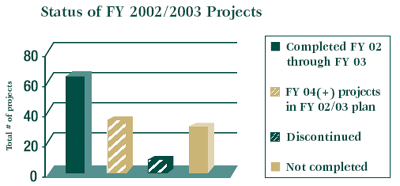
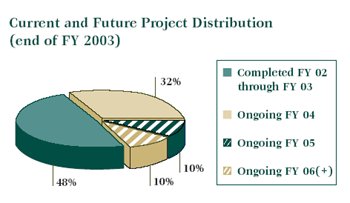
RD&T Success Stories
RD&T successfully completed and delivered projects
during FY 2002 and 2003 to support USDOT’s strategic goals and FHWA’s performance goals. The following highlights
showcase research implemented by FHWA and State DOTs.
Infrastructure
- New Bridge Specifications
At the annual meeting of the AASHTO Subcommittee on Bridges and Structures, June 1–6, 2003, a major rewrite of the Load and Resistance Factor Design (LRFD) steel bridge design code was adopted for implementation in the third
edition of the specifications. This is a major victory for FHWA’s curved girder bridge research initiative underway in the Structures Lab. Based on data developed by FHWA and a thorough review of the literature, new equations were developed that represent a major step to unify the design of straight and curved girder bridges into one
specification. Currently, the new equations are only adopted for straight girders, but they are developed to handle curved girder
design in the near future. The current plan is to present modifications to fully incorporate curved girders at the 2004 AASHTO meeting. The ongoing composite bridge test has been designed to provide key data for the 2004 code revisions.
FHWA played a key role in developing the new
specifications. Researchers working under a task order to the Structures
Lab support contract authored the new code provisions. The FHWA project produced much of the supporting data,
including both full-scale lab tests and computer-generated data using finite element analysis. Extensive peer review of
the process was provided through numerous meetings of an expert working group hosted by FHWA and the American Iron and Steel Institute. The effort was fully coordinated with researchers working to develop an LRFD curved girder specification under NCHRP project 12-52.
The new specifications offer several significant advantages compared to existing ones. The entire steel bridge design process has been simplified while providing a more
consistent level of reliability for steel bridges. More important,
the foundation has been laid to fully integrate straight and
curved girder bridge design. The current process requires
designers to work back and forth between different specifications.
The payoff is that the new specification should improve the
efficiency of steel bridge design, resulting in lower cost and probability of error in the process. The research, ranked
as the top priority of the AASHTO Highway Subcommittee on Bridges and Structures, is an essential step to support
the AASHTO and FHWA goal to have all States using the LRFD design code for all Federal-aid bridges by 2007.
- Physical Properties of Ultrahigh-Performance Concrete (UHPC)
Reactive powder concrete (RPC) has been introduced as a structural material for highway bridges. The material
consists of a finely graded cement paste with embedded steel fibers measuring approximately 0.2 millimeters (mm) in diameter and 12 mm in length. RPC has very high strength, stiffness, and toughness. The elastic properties of this
new material depend on proper casting and curing of the
concrete. Researchers at TFHRC have developed a new, nondestructive method of determining the elastic properties. The technique uses acoustic waves to determine the modulus of elasticity for the material, and is being developed as a
quality control tool for future construction using RPC. The
acoustic method correlates well with conventional destructive
methods of determining the modulus of elasticity. The new
technology will provide a cost-effective tool for evaluating the quality of UHPC in the field. Acoustic techniques for the detection of deterioration and cracking of this new
material have also been developed that will assist in the condition assessment of UHPC structure in the future.
- Commercial Test Kits for Quantifying Chloride on Steel Surfaces
FHWA published the “Assessment of Commercial Test Kits for Quantifying Chloride on Steel Surfaces” in the August 2003 issue of the Journal of Protective Coatings and
Linings. This paper provides a comprehensive comparison of three different commercial chloride test kits and points out the strengths and weaknesses of each. FHWA investigated and compared the efficiency of the swab, patch, and sleeve
test kits for extracting chloride contaminated steel surfaces
at four different chloride levels. It was found that the
efficiency decreases significantly after the steel surface was
exposed at 37 °C and 78 percent relative humidity for 4 hours; therefore, it is highly recommended that chloride tests should be conducted as soon as possible after the sand blasting of
steel surfaces. The guidelines and recommendations for
performing chloride extractions efficiently and accurately in the
field were given in this publication; they will help government agencies, States, and industry groups to obtain more
accurate chloride concentrations on steel surfaces prior to paint
applications. Accuracy of chloride determination is critical to the performance of coatings on steel surfaces of highway
bridges. This journal paper is widely distributed and considered as
the most comprehensive study of the current chloride test
kits. For further information, please contact Dr. Shuang-Ling
Chong at shuang-ling.chong@fhwa.dot.gov.
- Superpave
The United States invests more than $15 billion in each
year to construct and resurface roads with HMA. This annual investment requires at least 500 million tons of HMA, held together by about 30 million tons of liquid asphalt
binder. The Superpave system, developed under the Strategic Highway Research Program (SHRP), is the primary mechanism used by State highway agencies to purchase liquid asphalt binder and design asphalt mixtures. In close
partnership with TRB, FHWA continues its leadership role in refining the Superpave specifications and testing
procedures. Recent innovations include modifying the low-temperature binder specification and incorporating an FHWA-developed device to increase lab mixture compaction uniformity in the gyratory.
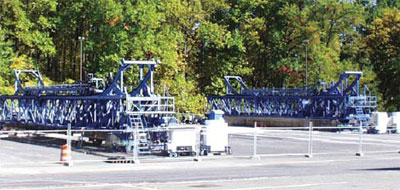
- HIPERPAV
Originally developed in 1996, the High-Performance Paving Software (HIPERPAV) is a powerful tool that helps highway organizations build long-lasting concrete pavements. When used in the design and construction phases of a concrete paving project, HIPERPAV can help engineers achieve a
highquality product at minimal cost by optimizing pavement and overlay design, optimizing mix design and temperature
characteristics, and reducing long-term performance uncertainties. HIPERPAV II expands the modeling capabilities to consider early-age behavior of continuously reinforced concrete
pavements (CRCP) and longer-term behavior of jointed concrete pavements (JCP), in addition to the early-age JCP and
bonded concrete overlay capabilities provided in early versions.
- Construction Quality Assurance Manual
This manual, the product of a State planning and research pooled fund study, is a comprehensive guide for State
highway agencies that wish to develop new, or modify existing, acceptance plans and quality assurance specifications. It provides necessary instructions and illustrative examples
to lead the agency through the entire process of acceptance plan development, which includes three phases—initiation and planning, specification development, and
implementation. The manual is centered around a flowchart presenting the steps in each of the three phases, with the text
containing a detailed discussion for each step. Through the use of proper, well-established analytical tools described in the manual, effective quality control and acceptance
procedures can be incorporated into quality assurance specifications that are fair to both the contractor and the highway agency.
- DataPave Online
DataPave was designed by the Long-Term Pavement Performance (LTPP) program to reach out and provide the global highway community with the most up-to-date data available from this 20-year study of in-service pavements. On January 17, 2003, the LTPP products team launched the next generation of this software online. Since then, the Web
site has evolved into one of the greatest success stories in
2003 for the LTPP program, supplying more than 500 users with more than 3.14 GB of information in a steadily increasing number of data exports (4,191 to date). The number of registered users has grown to include many from Argentina, Australia, Brazil, Canada, Chile, Denmark, England,
Finland, France, Greece, Hong Kong, Hungary, Iran, Italy, Japan, Korea, Netherlands, New Zealand, Portugal, Singapore,
Spain, Turkey, Zimbabwe, and other countries. This product has shown the importance of providing our customers with an easy way to obtain LTPP data.
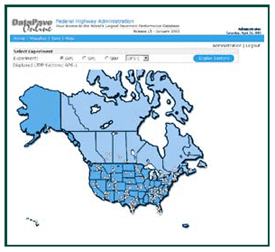
- New LTPP Falling Weight Deflectometer (FWD) Calibration Center in Colorado
LTPP, in conjunction with the Colorado DOT, established a new FWD calibration center in Denver, CO. The new center replaces the previous Reno, NV, facility and will serve
the LTPP Program’s Western Region. The move from Reno was triggered by what the Nevada DOT considered to be an
overburden in staffing requirements for the calibration center. Understanding the need for these centers, and the benefit of convenience in location, the Colorado DOT offered to host the new facility.
The LTPP calibration centers are supported jointly by the FHWA LTPP program and the host State highway agencies. LTPP provides the equipment, procedures, protocols, and technical support, while the States supply the facilities
and staff. The FWD calibration centers provide a vital service
to the transportation community, ensuring that FWD owners and operators have a place to keep their equipment
properly calibrated. Calibration on a regular basis gives the FWD owners and operators the best possible assurance that they are collecting reliable data.
Several visits were made to the Colorado DOT to evaluate the structural and spatial adequacy of the facility to
meet the requirements of FWD calibration. Testing was performed on the concrete test slab, electrical source, temperature control, and ventilation. These tests indicated that some modifications were needed, including improving the ground in the source circuit to reduce electrical noise; sawing
the concrete test slab to isolate vibration to the
surroundings; and working with the users of an adjacent garage bay to allow more space for maneuvering equipment. Training visits were also made to ensure that the new staff was comfortable with the calibration procedures.
- Partnering To Save Time and Money on a Critical Infrastructure Project
During the foundation construction for the new Woodrow Wilson Bridge in Washington, DC, a tremie concrete seal
dislodged from one of the main piers and fell to the bottom of the Potomac River. Although this had no immediate effect on the structural stability or integrity of the main pier
(the tremie concrete enabled dewatering for construction of the pier cap), there was concern about the long-term scour
effects of the thicker tremie seal that was originally proposed as
a solution to the problem. The Maryland Division Office, the FHWA Resource Center, and FHWA’s Hydraulics Lab provided technical assistance to the Maryland State Highway Administration. FHWA tested physical models of the new pier configuration in the flume at TFHRC to estimate the long-term scour effects. The tests confirmed that bridge safety was not affected by the change, and this major
project continued on schedule.
- Report Estimates Cost of Corrosion in the United States
FHWA published the Corrosion Cost and Preventive
Strategies in the United States, a report that provides a comprehensive
and current estimate of the total economic effect of metallic
corrosion in the United States and identifies national strategies to minimize the impact of corrosion. Corrosion’s total
direct cost is estimated at $276 billion per year. FHWA analyzed
the effects of corrosion in 26 industrial sectors and
extrapolated these results for a nationwide cost estimate. Sectors were divided into five major categories: infrastructure,
utilities, transportation, production and manufacturing, and
government. The conservative estimate of the indirect cost is equal to the direct cost of corrosion. The report is widely
referenced as the most authoritative, comprehensive, and current study of corrosion cost in the United States. Further
information is available at http://www.corrosioncost.com.
- Serving Internal Customers: The Office of Infrastructure R&D Delivers a New Tool to FHWA Bridge Engineers
This project developed a Web-based system to access the National Bridge Inventory (NBI), with search and analysis capabilities that enable FHWA bridge engineers to better understand the relationship between bridges, bridge
conditions and capacities, and bridge performance in the national transportation system. Web-NBI is the Web-based NBI system that engineers may use to access and analyze NBI data.
Its functionality includes:
- Ability to download NBI files in Microsoft® Access or ASCII text format for any State.
- Ability to create dynamic queries, browse the results,
and download the results.
- Ability to perform dynamic cross-tab queries and browse the results.
- Ability to generate dynamic NBI bar charts or to
generate bar charts from query results.
- Access to standard queries—graphs and maps are
preformatted and are readily available to browse or download.
- Partial support to map bridge records from NBI queries and display significant bridge environment features such as roads, rivers, and rail lines.
- Dynamic thematic map generation that displays bridge information such as the number of deficient bridges by county.
- Ability to generate structure inventory and appraisal reports.
These capabilities are now on the desktop of every bridge engineer within FHWA to ensure the safety, reliability,
and security of the Nation’s highway bridges.
- Cost-Effective Rehabilitation Strategies Using FWD Calibration Centers
Billions of dollars are spent annually on pavement
rehabilitation and resurfacing. To make the best possible decisions about where and when to conduct pavement rehabilitation work, State DOTs need extensive data on the pavement’s structural condition. These data are obtained by using accurately calibrated equipment. FHWA calibration centers provide a critical resource to the States, which rely on
consistent and accurate data to properly assess the structural condition of our Nation’s highways and allocate limited resources effectively.
- High-Performance Concrete (HPC) Contributes to Rapid Bridge Reopening
The successful rapid replacement of the U.S. I-65 bridge
in Birmingham, AL, demonstrated what was achieved by using innovative practices and materials developed by FHWA R&T. After closure from an accident, the bridge was replaced and traffic capacity restored in a record 67
days.
- COST (Concrete Optimization Software Tool)
HPC offers tremendous potential for improving the highway infrastructure. However, that potential relies on the
correct mix components in the proper proportions for each project. COST is an online design and analysis system that enables concrete producers, engineers, and researchers to
determine optimal concrete mixture proportions, making the highly complex mix design process more efficient and more
manageable. Available online at http://ciks.cbt.nist.gov/cost/, COST is the culmination of a highly successful joint
research effort by members of the Portland Cement Concrete Pavement (PCCP) team and researchers from NIST.
- Curved Structure Test
A series of 16 experimental tests were performed to fully quantify the strength of curved I-girder components (8
bending specimens, 4 shear specimens, and 4 moment-shear interaction specimens). An erection study was also
conducted to investigate construction issues associated with horizontally curved steel I-girder bridges. The full-scale
tests were used to validate a state-of-the-art computer
simulation model that enabled researchers to generate thousands of “virtual” data points. Combined, these new data provided
the basis for a complete rewrite of the AASHTO specifications for steel bridge design. The study began several years ago for the purpose of establishing LRFD codes for curved steel girders. The final testing phase will investigate elastic system behavior as well as ultimate bridge strength.
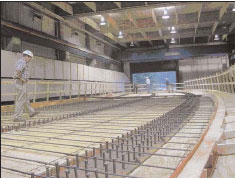
Operations
- ITS Intersection
U.S. Transportation Secretary Norman Y. Mineta announced the opening of RD&T’s newest test facility at TFHRC.
The test intersection is the first of its kind in the United
States and was designed to highlight intersection collision-avoidance systems that currently are being developed by the Infrastructure Consortium, a pooled fund with the States of California, Minnesota, and Virginia. This activity is sponsored in large part by the Intelligent Vehicle Initiative (IVI), a component of the ITS program. In addition to the traffic signals, controllers, special signing, and other equipment needed
to support the operation of the intersection, a unique
roadside-to- vehicle communication system will allow drivers of specially equipped vehicles to receive a warning when an intersection crash is imminent. In addition to supporting the intersection collision-avoidance demonstration, the
new “intelligent intersection” will continue to serve as an
outdoor lab for future FHWA intersection and traffic control research activities.
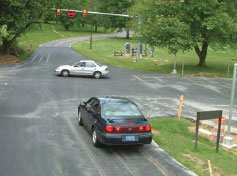
- QuickZone
The recently released QuickZone software is a work zone delay estimation tool that will provide a more complete
and realistic view of total construction costs. QuickZone is a
key component of FHWA’s Strategic Work Zone Analysis Tools (SWAT) program. The QuickZone partnership program enables users to take advantage of open source code to
customize the QuickZone software, thus providing State and local agencies with a tool that best meets their needs.
With QuickZone, State highway agencies can evaluate a broad range of alternative work zone design and mitigation
strategies in a relatively short time frame, resulting in better
decisionmaking for highway construction projects. A recent QuickZone benefits study verified this important aspect of the program—traffic engineers were able to better predict the traffic effects of various work zone design strategies
and more accurately stage their projects, thus saving money
and time (see the RD&T Research Benefits Case Studies
later in this report).
- Traffic Software Integrated System (TSIS)
A new version of the TSIS was released. Containing
numerous new features and enhancements requested by users, TSIS allows traffic engineers and planners to simulate
traffic conditions and evaluation alternative advanced traffic
management and control strategies to improve operations in an integrated network of arterials and freeways.
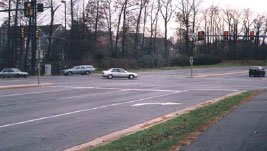
- Adaptive Control Software (ACS)
ACS adjusts traffic signal timing to accommodate changing traffic patterns, helping to reduce stops and delays. Field testing and
evaluation of two new ACS algorithms was completed in Seattle, WA, and Tuscon, AZ. The new ACS systems showed a 3–10 percent reduction in delay over traditional, fully
optimized signal timing plans.
- Traffic Detector Handbook
The Traffic Detector Handbook is a widely used reference
to help practicing engineers and technicians plan, design,
install, and maintain vehicle sensors that support traffic
management on arterials and freeways. The handbook recently was updated to reflect new sensor and detection technologies that support advanced traffic management and ITS
strategies.
- Nationwide Differential Global Positioning System
NDGPS can pinpoint a person or vehicle’s position to
within 3 meters. NDGPS directs emergency responders to the exact location of a crash, makes it easier for highway agencies
to monitor and respond to hazardous pavement conditions,
provides drivers with in-vehicle route guidance, and contains a host of other transportation applications. NDGPS sites
will form part of a nationwide operational GPS meteorological observing system that will enable the National Weather Service to provide more accurate weather forecasting.
- High-Accuracy Nationwide Differential Global Positioning System (HA-NDGPS)
As part of its ongoing research efforts, RD&T modified
an existing NDGPS facility to broadcast corrections that
achieve 10-centimeter horizontal accuracy. Initial testing of the
HANDGPS indicates that the new broadcast is accurate to within 10 centimeters and better in many areas. Further research
is underway to modify an additional NDGPS facility to achieve faster and even more accurate navigation solutions.
Safety
- 2003 Release of the Interactive Highway Safety Design Model
The 2003 release of IHSDM culminates a multiyear R&D effort. Highway project decisionmakers now can use IHSDM to check designs for conformance with design policy,
estimate their expected safety performance, and diagnose potential safety and operational issues throughout the highway design process.
The 2003 release of IHSDM for two-lane rural highways has five evaluation modules: 1) policy review; 2) crash prediction; 3) design consistency; 4) intersection review; and 5)
traffic analysis. Each module provides different measures of the expected safety performance of an existing or proposed highway geometric design.
The policy review module automates the current process of checking a design against applicable, quantitative
design guidelines. The crash prediction module provides
quantitative safety performance measures, including expected crash frequency and severity.
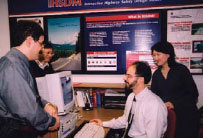
The remaining modules diagnose factors contributing to safety performance. The design consistency module assesses operating speed consistency. The intersection review module evaluates design elements that influence the safety performance of at-grade intersections. The traffic
analysis module evaluates traffic operations on the roadway under current or projected traffic loads.
Additional capabilities are planned for future releases. Research is underway to develop capabilities for IHSDM to perform similar evaluations of multilane rural highways. A sixth evaluation module for two-lane rural highways, driver/vehicle, also is being developed and will provide measures of vehicle dynamics, including lateral
acceleration and rollover and skidding potential (from Public Roads, January/February 2003, Vol. 66, No. 4, by R.A. Krammes and C. Hayden).
- Rumble Strips
Rumble strips are raised or grooved patterns constructed
on the roadway’s shoulder. Vehicle tires passing over them
produce a rumbling sound and cause the vehicle to vibrate. The noise and vibration produced by the strips are effective alarms for drivers who have drifted from their travel lane onto the shoulder. Several studies indicate that the
strips can reduce the overall rate of run-off-the-road crashes by 15–70 percent, which also would lead to a reduction in the number of injuries and fatalities.
FHWA has developed a Web site to address the crucial role of shoulder rumble strips. The site includes FHWA’s Technical Advisory on Roadway Shoulder Rumble Strips and a synthesis of rumble strip information. The technical
advisory provides FHWA’s guidance on where and when rumble strips should be used. The synthesis is a review of the
current practices of State DOTs, a review of recent shoulder rumble strip studies, and a review of common practices. The Web site can be found at http://safety.fhwa.dot.gov/roadway_dept/pavement/rumble_strips/ (from Public Roads, January/February 2003, Vol. 66, No. 4, by A.J. Nedzesky and R. Powers).
- Highway Safety Information Systems (HSIS)
HSIS is a multistate information system that contains
accident data for more than 5 million crashes, information about traffic volumes, and roadway inventory data covering approximately 265,650 kilometers of State highway systems. FHWA staff, contractors, university researchers, and
others use HSIS to study current highway safety issues, to direct research efforts, and to evaluate the effectiveness of
accident countermeasures. Through HSIS, FHWA works closely with States and other partners to gather data and improve our ability to analyze roadway safety challenges. HSIS
helps FHWA direct investments to specific projects and programs that will deliver the most value in terms of saving lives
and minimizing injuries.
- Pedestrian and Bicycle Crash Analysis Tool (PBCAT)
Researchers at FHWA, in cooperation with the National Highway Traffic Safety Administration (NHTSA), developed the PBCAT to assist State and local coordinators,
planners, and engineers with analyzing crashes and developing
effective countermeasures. By analyzing data from actual crashes, such as where and when they occurred,
characteristics of the victims, and the sequence of events leading up to the crashes, the PBCAT software can produce tables and graphs illustrating the relationships among various crash types and other factors associated with the crashes (age, gender, light conditions, etc.). PBCAT also provides
recommended countermeasures linked to specific pedestrian and bicycle crash types. The PBCAT software and manual (FHWA-RD-99-192) are available at www.bicyclinginfo.org/bc/pbcat.htm (from Public Roads, January/February 2003, Vol. 66, No. 4, by C. Tan Esse).
- Roundabouts Information Guide
FHWA developed Roundabouts: An Informational Guide, to help communities improve safety and mobility by placing roundabouts in appropriate areas. Experiences in the United States show that roundabouts reduce crashes by 37 percent, and decrease crashes involving injuries by 51 percent.
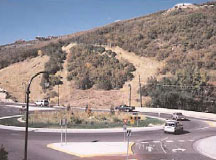
- Highway Design Handbook for Older Drivers and Pedestrians
Based on the characteristics of older drivers and
pedestrians, this resource provides practitioners with practical
information for incorporating specific roadway features into highway design, operations, and traffic engineering. The handbook showcases tools that address issues that enhance older driver and pedestrian safety and mobility.
Back to Top
IV . Performance Management
Relevance, Quality, and Performance
The Office of RD&T uses criteria established by OMB— Relevance, Quality, and Performance—as the bases for assessing the need, relevance, appropriateness, quality,
and performance of our research activities. Our approach to
performance management builds on these three elements.
Relevance. RD&T program managers must be able to
articulate why an investment is important, relevant, and appropriate. Our research activities, products, and services outlined in this plan are designed to support the Agency’s goals and address customer needs.
Quality. RD&T program managers must justify how funds will be allocated to ensure quality research. Programs
allocating funds through means other than a competitive, meritbased process must justify these exceptions and document how quality will be maintained. Quality is also assessed periodically through independent lab assessments.
Performance. RD&T program managers must be able to monitor and document how well this investment is
performing. Program managers track R&T projects to determine whether the projects are on time and within budget, and assess whether to increase or redirect funding.
Planning and Priority Setting
FHWA’s Office of RD&T coordinates the R&T program
and supports FHWA and USDOT strategic goals for the Nation’s transportation system. The FY 2002/2003 RD&T
Performance Plan outlines FHWA research priorities and strategies and shows a clear link between research program goals and FHWA and USDOT strategic plans. Research highlighted in the RD&T performance plan focuses on providing
solutions to complex technical problems by developing economical, environmentally sensitive designs; efficient, quality-controlled construction practices; and durable
materials. The result will be a safer, more reliable highway
transportation system.
Performance Management Framework
Different forms of evaluation are appropriate for
different types of research programs and projects. The RD&T Performance Management Framework chart identifies
performance measures used across the various organizational functions. It is used as an assessment mechanism for unit managers and helps to establish measures that are integrated across management functions. The framework reflects our Agency’s Corporate Management Strategies (CMS), which are based on the Baldrige Criteria. The
framework is a tool for managers to analyze and integrate
information obtained from a variety of sources and mechanisms. It also helps ensure that various dimensions for analyzing program results, such as financial performance, customer feedback, and business results are examined
comprehensively. The RD&T Leadership Council utilizes this framework as a tool to assess relevance, quality, and performance, and to identify gaps in measurement.
RD&T Performance Management Framework
| CMS
|
Definition |
Related RD&T Performance Measures |
Methodology |
| Leadership |
Leadership focuses on how senior leaders guide the organization. It describes how leaders set direction and high-performance expectations, project a strong customer focus, and communicate clear and visible values to employees. |
- Leadership Effectiveness Inventory (LEI) results.
- Action items completed.
- Performance plan items fulfilled.
- Self-assessment score.
|
- 360-degree feedback.
- Action agenda.
- Performance plans.
- Quality self assessments.
|
| Strategic Planning |
Strategic planning examines how the organization sets strategic goals and develops key action plans. |
- Action items completed.
- Self-assessment score.
- Progress made on goals established from lab assessment.
|
- Performance plans and action agenda.
- Quality self assessments.
- Lab assessments.
|
| Customer/ Partner Focus |
Customer and partner focus examines how the organization determines requirements and expectations of customers and markets. |
- Percent of satisfaction with RD&T products and
services.
- Number of TFAPs in place.
- Self-assessment score.
- Lab assessment results.
- RD&T customer survey results (to be determined).
|
- FHWA satisfaction survey.
- TFAP.
- Quality self assessments.
- Lab assessments.
- Customer surveys.
- Web feedback links.
|
| Information and Analysis |
Information and analysis examines the management, effective use, and analysis of data and information to support key organization processes, to include the organization's objectives. |
- Performance measurement framework.
- Level and content of response on feedback mechanisms
used.
- Self-assessment score.
- Lab assessment results.
|
- Performance management framework.
- Quality self assessments.
- Lab assessments.
|
| Human Resource Development |
Human resource development and management examines how the organization enables its workforce to develop to its full potential and how the workforce is aligned with the organization's objectives. |
- Self-assessment score.
- Percent employee satisfaction survey rating.
- Percent payroll spent on training and development.
- Number of Individual Development Plans in place in the Learning and Development System (LADS).
- Number of priority 1 training needs met.
- Number of vacancies filled.
- Number of days positions are vacant.
- Number of student interns.
- Awards and recognition.
|
- Quality self assessments.
- Employee satisfaction survey.
- LADS.
|
| Process Management |
Process management examines aspects of how key production, delivery, and support processes are designed, managed, and improved. |
- Number of process improvements documented.
- Lab assessment.
- Number of contracts on time and on budget.
|
- Quality self assessments.
- Lab assessments.
- Project tracking system.
- Workload analyses.
|
| Business Results |
Business results show the organization's performance and improvement in its key business areas: customer satisfaction, financial and marketplace performance, human resources, supplier and partner performance, and operational performance. The category also examines how the organization performs relative to competitors. |
- Percent of project completion.
- Number of success stories.
- Research benefit.
|
- Track project and services delivery/deployment of T&I.
- RD&T success stories.
- Pilot and case studies.
|
Performance Management Workgroup
The primary purpose of the Performance Management Workgroup is to help the RD&T leadership develop,
coordinate, and implement organizational performance-improvement efforts. The workgroup also helps RD&T leadership
improve the management of research programs and assists in the
adoption of effective practices. Performance-management efforts currently underway include:
- Developing performance goals, measures, strategies, and initiatives to improve organizational performance
management in RD&T offices and labs.
- Monitoring results of measures and analyzing performance management information.
- Coordinating the annual self-assessment process and
supporting the RD&T Leadership Council in implementing solutions to issues raised during the process.
- Contributing to special projects related to RD&T
performance management.
- Providing support for Agency-wide
performance-improvement initiatives.
RD&T Research Benefits Case Studies
Measuring the contribution of highway research to the
achievement of Agency and departmental goals poses a unique challenge because of the long-term nature of research and the level of risk involved. Research projects are multiyear
undertakings, and the products developed from them undergo several years of evaluation and development before being accepted and implemented on a broader scale.
For such reasons, the USDOT acknowledges in its annual research, development, and technology plan that until the products of the research are fully developed and utilized,
“current (research) efforts can have only modest impact on the attainment of specific performance goals.” Over time, however, relevant and high-quality research programs can lead to
innovations that exponentially benefit the public and lead to growth in the private sector.
Retrospective reviews of whether investments were well directed, efficient, and productive are essential for
validating program design and instilling confidence that future
investments will be appropriate. Retrospective RD&T benefit
studies are conducted periodically to document the benefits of research products. RD&T periodically conducts benefits
case studies to collect data on the benefits of research and,
when possible, to document and gain further insight into
linkages with Agency goals and outcomes.
The first series of studies has yielded potential
performance measures for evaluating highway R&D databases,
software tools, national design and data standards, and new
materials technology. The methodologies used to determine the
benefits derived from the research were documented and
recommendations were made for measuring benefits both quantitatively and qualitatively. These metrics may be adapted and used
as part of a contextual framework for RD&T program
managers to assess the benefits of their research.
RD&T has conducted these evaluations with the
understanding that there is no single approach to the issue of research
performance measurement and benefits assessment and that a combination of evaluation methods within a unified
framework will most likely yield the best results. This holistic
perspective is supported by the findings of the NCHRP Synthesis 300 and is acknowledged by the OMB’s recommended criteria for investment in research. The RD&T benefit
assessments are largely retrospective analyses. However, similar
approaches may be used to predict future benefits of research
projects.
Case Study Highlights
Infrastructure R&D
HRDI completed a study that examined RD&T research
benefits in the areas of national design and data standards, new technologies, and new materials development. This project identified performance measures and provided a framework to assess the benefits of research conducted by HRDI. The performance measures were developed based on data
collected on selected projects completed by HRDI in the past 20 years. The guiding principle in the development of the
performance measures and assessment framework was to ensure that the measures are relevant, that they capture all
types of research activities, that they are objective enough to
highlight the benefits and weaknesses of research programs and
projects, and above all, are simple enough to be easily understood and applied by HRDI program managers.
Highway Safety Information System
HSIS is a multistate information system that improves
highway safety and design. The HSIS performance assessment goal was to provide value indicators for the system. These indicators will be used to develop a broader framework to assess the benefits of research databases and information tools. Value indicators developed for the study included
measurements of HSIS value to internal and external safety research communities, and to State and local engineers and planners. Examples of HSIS indicators included bibliometric usage data, expert peer review data, and user survey
results.
QuickZone
QuickZone’s evaluation results revealed several useful product benefit measures for State DOT planners. The combination of customer survey data and user cost and benefit modeling proved particularly useful and resulted in immediate improvements to the product’s input modules and analysis options. Software development is a research process that is difficult to measure with traditional metrics. The metric results from the study have a broader application
potential in determining research benefits for similar RD&T products, particularly any software or model development.
Customer Feedback
To determine whether our research products are meeting the needs of our customers, RD&T seeks and obtains
customer feedback through such mechanisms as formal surveys, Web links, and focus group meetings. A Customer Survey
Workgroup is helping the Leadership Council identify existing
mechanisms for customer feedback and to assess the need for surveys
geared to specific segments of our customer base. A chart showing extensive stakeholder involvement throughout the R&T
process was posted on Staffnet. The group is currently working
with HAAM to test a Web-based survey it has developed that
focuses on customer satisfaction with RD&T products.
RD&T Lab Assessment Process
RD&T lab assessments are independent expert reviews of
the quality and performance of research conducted at TFHRC.
The assessment process is designed to:
- Enhance lab performance and quality by providing
feedback to lab managers.
- Provide an opportunity to exchange views among technical experts.
- Create a feedback method that will increase the
opportunities for customer and stakeholder input to research activities.
- Provide a credible, professional, and objective
assessment that further improves stakeholder confidence in the value of the work performed and outcomes produced.
Stakeholder Advisory Activities and Feedback
The Research and Technology Coordinating Committee (RTCC)
The RTCC examines national highway R&T needs and roles and provides policy-level recommendations on the overall direction of the program. The RTCC committee consists of
18 members, including top-level administrators, researchers,
and practitioners from the States, academia, and private
sector. RTCC activities in FY 2003 included several high-level
meetings with RD&T leadership and other highway research
stakeholders on highway R&T topics (most recently, a symposium was held April 3–4, 2003, in Washington, DC). The symposium elicited stakeholders’ views on how well highway
transportation R&T programs conducted by the Federal Government are addressing the full range of national R&T priorities.
Tools for Measuring Performance at the State DOT Level
RD&T staff participated in a workshop on performance
measures for State DOT research managers hosted by the Florida DOT in December 2002. One activity that grew out of that workshop, and subsequent discussions with the AASHTO RAC, was an NCHRP project to develop a performance measurement toolbox for State DOT researchers. In addition to the
toolbox, a database will be developed that will contribute to a
nationallevel report showcasing the benefits of State research.
Back to Top
Next
Performance Report Feedback |

